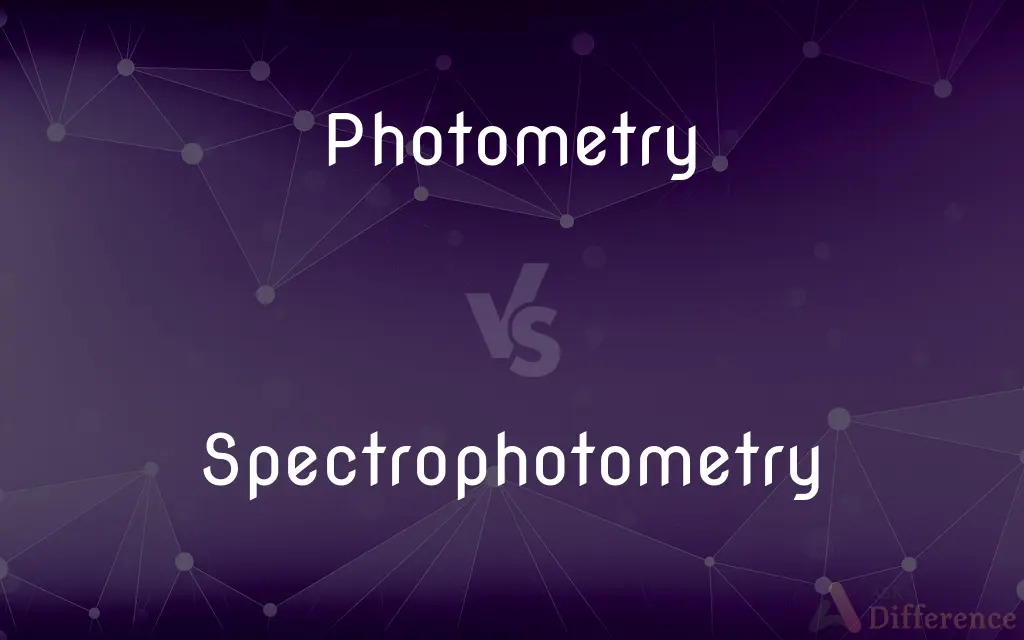Photometry vs. Spectrophotometry — What's the Difference?
By Tayyaba Rehman — Updated on November 6, 2023
Photometry measures the intensity of light, while spectrophotometry measures light intensity across a spectrum of wavelengths.

Difference Between Photometry and Spectrophotometry
Table of Contents
ADVERTISEMENT
Key Differences
Photometry is the science of measuring visible light in terms of its perceived brightness to the human eye. It is concerned with the measurement of light intensity without regard to wavelength. Spectrophotometry extends this concept by not only measuring the intensity of light but also analyzing the light across a wide range of wavelengths to gain a spectrum.
In photometry, one is generally concerned with the amount of light that passes through a medium or is emitted by a source. Spectrophotometry, meanwhile, is particularly useful for chemical analysis because different substances absorb and transmit light differently at different wavelengths.
The tools used in photometry include photometers, which are designed to measure the intensity of light as a single value. Spectrophotometers, on the other hand, are equipped with monochromators or diffraction gratings to disperse light into its component wavelengths before measuring its intensity.
While photometry is commonly applied in fields such as astronomy to measure stellar brightness, spectrophotometry is essential in laboratories for determining the concentration of substances in a solution. It does so by applying Beer-Lambert’s law, correlating absorption with concentration.
Photometry often deals with broader light measurements that can include various light sources and luminous objects. Spectrophotometry is a more specialized form of photometry that provides detailed information about how an object interacts with various wavelengths, giving insight into the object's composition and structure.
ADVERTISEMENT
Comparison Chart
Definition
Measurement of light intensity.
Measurement of light intensity across a spectrum.
Application
Broad, including illumination engineering, astronomy.
Specific, including chemical analysis, biology.
Measurement
Total light without wavelength discrimination.
Light intensity at specific wavelengths.
Equipment
Photometers.
Spectrophotometers with monochromators or diffraction gratings.
Data Obtained
Single value of light intensity.
Spectrum showing intensity at multiple wavelengths.
Compare with Definitions
Photometry
It involves the use of photometers and other optical instruments.
The engineer used photometry to test the new streetlights.
Spectrophotometry
Involves dispersing light into a spectrum to analyze material properties.
Spectrophotometry was key to identifying the pigments in the ancient textile.
Photometry
The study of the measurement of light.
Photometry is crucial in determining the luminous efficiency of light bulbs.
Spectrophotometry
A method to measure how much a chemical substance absorbs light.
He used spectrophotometry to analyze the purity of the chemical.
Photometry
Photometry assesses the intensity of light from various sources.
Photometry was used to measure the brightness of the night sky.
Spectrophotometry
Utilizes specific wavelengths to ascertain concentrations of substances.
Spectrophotometry is routinely used in labs for blood analysis.
Photometry
A branch of science that quantifies light perceived by the human eye.
His research in photometry helped improve the design of lighting systems.
Spectrophotometry
The quantification of light absorption in a substance across wavelengths.
Spectrophotometry revealed the concentration of the sample solution.
Photometry
Measurement of the properties of light, especially luminous intensity.
Spectrophotometry
It's applied to determine the molecular composition of samples.
Through spectrophotometry, they detected trace elements in the water.
Photometry
(physics) The measurement of various aspects of light, especially its intensity.
Spectrophotometry
Spectrophotometry is a branch of electromagnetic spectroscopy concerned with the quantitative measurement of the reflection or transmission properties of a material as a function of wavelength. Spectrophotometry uses photometers, known as spectrophotometers, that can measure the intensity of a light beam at different wavelengths.
Photometry
(astronomy) The measurement of the intensity and spectrum of light from stars.
Spectrophotometry
An instrument used to determine the relative intensity of various wavelengths in a spectrum of light.
Photometry
That branch of science which treats of the measurement of the intensity of light.
Spectrophotometry
The quantitative analysis of electromagnetic spectra by use of a spectrophotometer; especially in order to determine the structure or quantity of a substance
Photometry
Measurement of the proterties of light (especially luminous intensity)
Spectrophotometry
The art of comparing, photometrically, the brightness of two spectra, wave length by wave length; the use of the spectrophotometer.
Photometry
Applies principles of optics to measure visible and ultraviolet light.
The museum installed a photometry system to protect light-sensitive artifacts.
Spectrophotometry
The art or process of measuring the degree of absorption of light at different wavelengths by a chemical substance, by means of a spectrometer or spectrophotometer. It is a technique for chemical analysis.
Common Curiosities
What is photometry?
Photometry is the science of measuring visible light in terms of its intensity.
What does spectrophotometry reveal about a substance?
It can reveal chemical composition, concentration, and purity by analyzing how a substance absorbs light at various wavelengths.
What is spectrophotometry?
Spectrophotometry is the measurement of light intensity at different wavelengths to obtain a spectrum.
How do photometry and spectrophotometry differ in use?
Photometry is often used in astronomy and lighting design, while spectrophotometry is used in chemical and biological analysis.
Is spectrophotometry better than photometry?
Not necessarily better, but spectrophotometry provides more detailed information for certain applications.
Can photometry detect color?
Photometry measures light intensity but does not specifically analyze colors without wavelength information.
Do photometers measure UV light?
Some photometers are designed to measure UV light, depending on their sensor capabilities.
Can photometry be used for safety testing?
Yes, it can be used to ensure lighting meets safety standards for visibility and comfort.
Can spectrophotometry analyze solids?
Yes, with appropriate sample preparation, solids can be analyzed.
Can I measure LED light with photometry?
Yes, photometry can be used to measure the intensity of LED light.
How accurate is spectrophotometry?
It is very accurate for quantitative analysis when properly calibrated.
What role does spectrophotometry play in water testing?
It's used to identify and quantify pollutants and chemicals in water samples.
Are photometry and spectrophotometry related to photography?
They are related in terms of light measurement but are not directly involved in the art of photography.
What are some limitations of photometry?
Its limitations include insensitivity to variations in light color and wavelength distribution.
Does photometry involve color filters?
Yes, photometers can use color filters to measure light of specific colors.
Share Your Discovery

Previous Comparison
Graduation vs. Graduate
Next Comparison
Aniline vs. BenzylamineAuthor Spotlight
Written by
Tayyaba RehmanTayyaba Rehman is a distinguished writer, currently serving as a primary contributor to askdifference.com. As a researcher in semantics and etymology, Tayyaba's passion for the complexity of languages and their distinctions has found a perfect home on the platform. Tayyaba delves into the intricacies of language, distinguishing between commonly confused words and phrases, thereby providing clarity for readers worldwide.














































